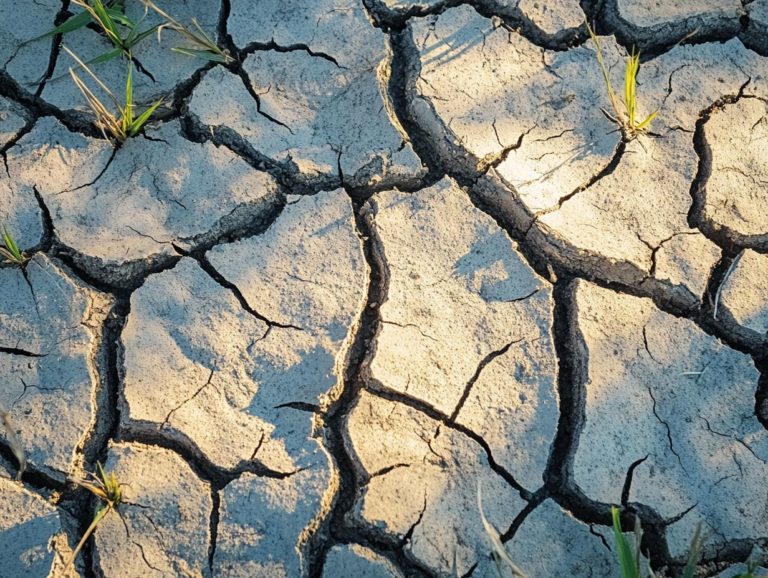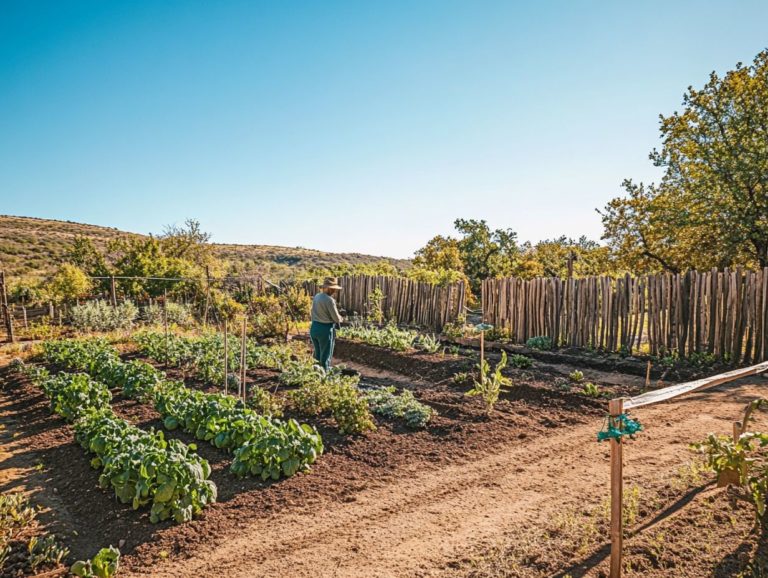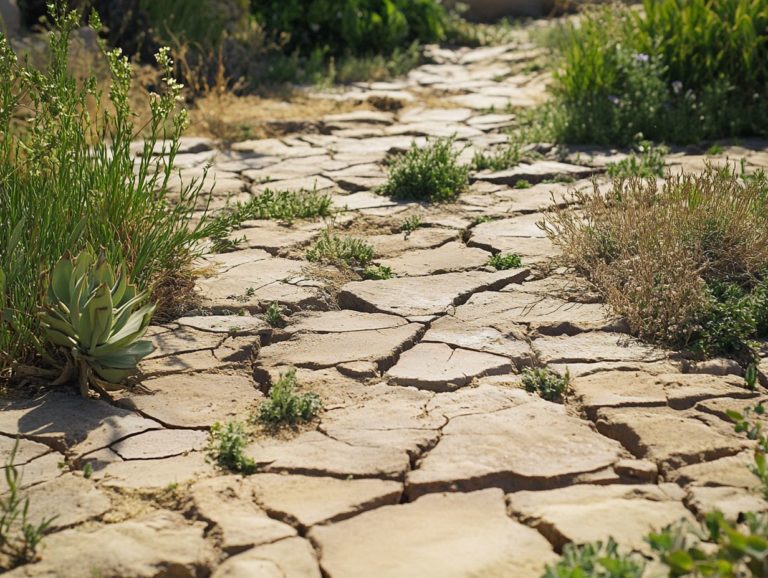Creating Shade in Drought-Tolerant Landscapes
As water scarcity emerges as a critical issue, the importance of designing drought-tolerant landscapes becomes undeniable.
One key aspect that often flies under the radar is the role of shade, which is vital for preserving plant health and soil moisture. Shade is integral to effective landscaping ideas.
This article delves into the significance of shade in these environments, comparing natural and artificial options while providing insights on the best drought-tolerant perennials and groundcovers for shaded areas.
You will find effective maintenance tips and innovative strategies to create shade, ensuring your water-saving landscape flourishes even in challenging dry conditions.
Contents
- Key Takeaways:
- The Importance of Shade in Drought-Tolerant Landscapes
- Types of Shade Structures
- Designing for Shade in Drought-Tolerant Landscapes
- Choosing Drought-Tolerant Plants for Shaded Areas
- Maintaining Shade in Drought-Tolerant Landscapes
- Alternative Methods for Creating Shade in Drought-Tolerant Landscapes
- Frequently Asked Questions
- How can I create shade in a drought-tolerant landscape?
- What are some drought-tolerant plants that can also provide shade?
- Can I use mulch to create shade in a drought-tolerant landscape?
- What are some drought-tolerant shade structures?
- How can I incorporate shade into a water-efficient landscape?
- Are there any maintenance considerations for creating shade in a drought-tolerant landscape?
Key Takeaways:

Shade is crucial for plant health and water conservation in drought-tolerant landscapes.
Both natural and artificial shade structures effectively provide shade for plants.
When designing and maintaining shade in drought-tolerant landscapes, consider factors such as plant placement and long-term coverage. For more detailed strategies, check out this guide on creating a drought-tolerant landscape.
The Importance of Shade in Drought-Tolerant Landscapes
Discover why shade is the secret to a flourishing garden in dry climates. In drought-tolerant landscapes, the significance of shade cannot be underestimated. It plays a pivotal role in preserving soil moisture, curbing water evaporation, and supporting the survival of native plants and ornamental grasses. For more ideas, explore these creative landscape ideas for drought areas.
As urban areas increasingly grapple with the challenges of water conservation and climate adaptation, incorporating shade into your garden design through effective water-saving gardening methods can foster an eco-friendly environment that flourishes with minimal resources.
Recognizing the myriad benefits of shade is essential for any gardener or landscape designer aspiring to create sustainable and stunning outdoor spaces.
Why Shade is Essential for Plants and Soil
Shade is essential for your plants and soil in a drought-tolerant landscape. It plays a vital role in regulating temperature and retaining moisture, both of which are crucial for the health of drought plants in landscapes.
By reducing water evaporation, shade creates an environment where your soil retains moisture for longer periods, ultimately decreasing the frequency of watering needed. It acts as a protective barrier against the harsh rays of the sun and extreme temperature fluctuations, which can lead to stress and damage to your plants.
To effectively incorporate shade into your garden, consider garden tips like:
- Strategically positioning taller plants
- Utilizing shade cloth
- Installing decorative structures like pergolas to create enticing covered areas
A well-planned, water-saving landscape not only nurtures healthier plants but also enhances soil health by minimizing erosion and maintaining vital nutrient levels.
Types of Shade Structures
Shade structures are must-haves for a thriving garden! They offer crucial protection for your plants from harsh sunlight while elevating the overall design and aesthetics of your garden.
By exploring the diverse types of shade structures both natural and artificial you can craft a balanced ecosystem that enhances water conservation and nurtures the growth of drought-resistant plants.
Whether you opt for trees, pergolas, or shade sails, each option brings unique advantages, especially when paired with efficient irrigation systems. This allows you to maximize soil moisture retention and minimize water usage.
Start implementing these strategies in your landscape today for a thriving garden that conserves water!
Natural vs. Artificial Shade Options
Natural shade options, like mature trees and shrubs, often present a more sustainable and visually appealing solution for drought-tolerant landscapes than artificial shade structures.
This is mainly because native plants thrive in your local climate and support local wildlife, fostering a balanced ecosystem. While artificial shade structures provide immediate sun relief, they typically require more materials and may disrupt natural habitats.
Maintaining natural options usually involves periodic pruning and watering during drier seasons. These efforts are manageable and contribute positively to your garden’s health.
In contrast, artificial structures may need repairs or replacements over time, which can diminish their charm, especially when considering eco-friendly alternatives.
Ultimately, incorporating native plants can significantly boost the longevity and resilience of your eco-friendly gardens, offering both shade and a sanctuary for beneficial species.
Designing for Shade in Drought-Tolerant Landscapes

Think about shade placement now for a thriving garden. Designing for shade in drought-tolerant landscapes requires a thoughtful approach to ensure that both plants and hardscape elements receive the right balance of sunlight and moisture essential for their vitality, especially when considering eco-friendly landscaping for drought conditions.
Careful planning is crucial to achieve a good balance between shade and sunlight, especially when selecting drought-resistant plants suited for shaded spots.
Incorporate a strategic layer of mulch to optimize soil conditions, enhance water retention, and maintain a stunning landscape that thrives even in arid conditions.
Factors to Consider in Shade Placement
When considering shade placement in drought-tolerant landscapes, assess various factors, such as the specific needs of different plants and your garden’s overall design. This evaluation will help you save water and keep your garden thriving!
Understanding the sunlight and moisture requirements of each plant type helps you avoid challenges like over-exposure or insufficient light, both of which can stunt growth. Thoughtful shade placement affects soil moisture levels and plays a crucial role in regulating temperature fluctuations, creating a stable environment for your plants.
If you’re gardening in shaded areas, incorporate efficient irrigation systems to maintain adequate hydration while minimizing water wastage. To truly optimize your shade design, think about layering foliage or using structures that create dappled sunlight. This approach fosters a thriving, diverse plant community that flourishes in harmony.
Choosing Drought-Tolerant Plants for Shaded Areas
Choosing the right drought-tolerant plants for shaded areas is crucial for cultivating a flourishing garden that conserves water and looks stunning. By selecting native plants, including drought-tolerant perennials and hardy groundcovers, you can enhance biodiversity and ensure your landscape remains both sustainable and low-maintenance.
When you understand the specific light and moisture requirements of various species, you empower yourself to make informed choices that foster healthy plant growth, even in challenging shaded environments.
Best Plant Options for Shaded Areas
When selecting plants for shaded areas in drought-tolerant landscapes, you ll find that resilient varieties like Heuchera, Mahonia repens, and Hypericum calycinum are your best bets. These plants are known for their adaptability. They also have low water requirements.
Not only do they thrive in limited sunlight, but they also add unique foliage colors and textures to your garden. Take Heuchera, commonly known as coral bells; its vibrant leaves can vary from deep purple to bright lime green. Mahonia repens, or creeping Oregon grape, features attractive spiky foliage and clusters of bright yellow flowers that later produce berries. Hypericum calycinum, often called creeping St. John’s wort, stands out with its striking yellow blooms and evergreen leaves.
For optimal growth, ensure you provide well-drained soil. Water them deeply but infrequently to promote strong root systems and prevent waterlogging, which means too much water can drown plant roots. Incorporating these plants into your shaded garden designs not only enhances the aesthetic appeal but also contributes to a sustainable landscape.
Maintaining Shade in Drought-Tolerant Landscapes
Maintaining shade in drought-tolerant landscapes is crucial for providing your plants with the necessary protection from the sun. This strategy enhances soil moisture retention and highlights the role of shade in drought gardening.
By keeping your garden in good shape, you can create an environment where your plants will thrive while conserving precious resources.
Tips for Ensuring Long-Term Shade Coverage

Ensuring long-term shade coverage in your drought-tolerant landscape involves a thoughtful blend of planning, consistent maintenance, and the strategic use of resources like irrigation systems and mulch, alongside using native plants in drought landscapes.
Take the time to discover what your plants need. Regularly monitoring soil moisture levels is crucial, as it significantly influences plant vitality. Finding the right balance is key; too much or too little water can spell trouble in a drought-tolerant landscape.
Incorporating mulch around your plants diminishes weed competition and enhances soil moisture retention. This natural layer serves as insulation, keeping the roots cool and helping to preserve moisture during dry spells.
With these practices in place, you can foster a resilient landscape that flourishes under varying conditions.
Alternative Methods for Creating Shade in Drought-Tolerant Landscapes
Consider exploring alternative methods for creating shade in your drought-tolerant landscape. You can incorporate innovative hardscape elements, choose eco-friendly alternatives, and apply thoughtful garden design, such as water features in drought-tolerant landscapes, to enhance plant health and promote effective water conservation.
Using Hardscape and Other Techniques
Using hardscape elements and other techniques in drought-tolerant landscapes offers a sustainable way to create shade while championing water conservation and elevating the garden’s aesthetic appeal.
Incorporating features like meticulously designed stone walls, expansive patios, and meandering pathways effectively manages sunlight exposure, reducing heat and evaporation that often deplete precious water resources.
These hardscape choices provide essential shade and serve as an inviting backdrop for carefully selected plant species that flourish in arid conditions. Thoughtful integration of these elements fosters a cohesive landscape that promotes moisture retention, ultimately enhancing the longevity and resilience of your drought-resistant flora.
Frequently Asked Questions
How can I create shade in a drought-tolerant landscape?
There are several ways to create shade in a drought-tolerant landscape:
- Using trees
- Incorporating shrubs
- Adding vines
- Using shade structures like pergolas or arbors
What are some drought-tolerant plants that can also provide shade?

Drought-tolerant plants that provide shade include oak, maple, and elm trees. You can also consider yucca, cacti, and succulents.
Can I use mulch to create shade in a drought-tolerant landscape?
Yes, mulch effectively creates shade in a drought-tolerant landscape. A thick layer around plants keeps the soil cool and reduces water evaporation.
What are some drought-tolerant shade structures?
Popular drought-tolerant shade structures include pergolas, arbors, and shade sails. These not only provide shade but also add architectural interest to your space.
How can I incorporate shade into a water-efficient landscape?
To incorporate shade, strategically place taller plants and shade structures in sunny areas. Using drought-resistant plants that naturally provide shade is also a great option.
Are there any maintenance considerations for creating shade in a drought-tolerant landscape?
Regularly pruning and maintaining shade-providing plants is crucial to prevent overgrowth. Monitor and adjust shade structures to ensure they provide adequate cover throughout the day.






